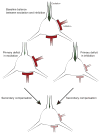Excitatory/Inhibitory Balance and Circuit Homeostasis in Autism Spectrum Disorders
- PMID: 26291155
- PMCID: PMC4567857
- DOI: 10.1016/j.neuron.2015.07.033
Excitatory/Inhibitory Balance and Circuit Homeostasis in Autism Spectrum Disorders
Abstract
Autism spectrum disorders (ASDs) and related neurological disorders are associated with mutations in many genes affecting the ratio between neuronal excitation and inhibition. However, understanding the impact of these mutations on network activity is complicated by the plasticity of these networks, making it difficult in many cases to separate initial deficits from homeostatic compensation. Here we explore the contrasting evidence for primary defects in inhibition or excitation in ASDs and attempt to integrate the findings in terms of the brain's ability to maintain functional homeostasis.
Copyright © 2015 Elsevier Inc. All rights reserved.
Figures



References
-
- Asaka Y, Jugloff DG, Zhang L, Eubanks JH, Fitzsimonds RM. Hippocampal synaptic plasticity is impaired in the Mecp2-null mouse model of Rett syndrome. Neurobiol Dis. 2006;21:217–227. - PubMed
-
- Barros CS, Calabrese B, Chamero P, Roberts AJ, Korzus E, Lloyd K, Stowers L, Mayford M, Halpain S, Müller U. Impaired maturation of dendritic spines without disorganization of cortical cell layers in mice lacking NRG1/ErbB signaling in the central nervous system. PNAS. 2009;106:4507–4512. - PMC - PubMed
Publication types
MeSH terms
Grants and funding
LinkOut - more resources
Full Text Sources
Other Literature Sources

